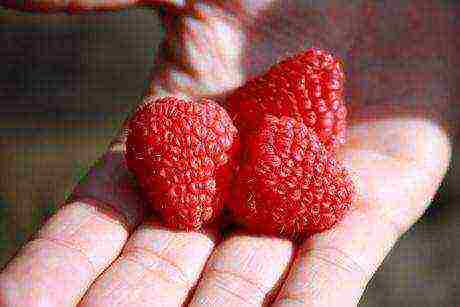Content
- 1 Varietal variety of white cabbage
- 2 Most Popular
- 3 What varieties of cabbage are best grown in different regions of Russia
- 4 Early varieties of white cabbage
- 5 Medium white cabbage
- 6 Late varieties of white cabbage
- 7 New resistant cabbage varieties for minimal processing
White cabbage is an incredibly healthy vegetable with a rich vitamin and mineral composition. This explains its popularity among gardeners. The cultivation rules are not complicated, but the basis for the yield depends on the choice of the variety.
Varietal variety of white cabbage
In the old days, there was really a shortage of seed material due to limited supplies from the near and far abroad, therefore, the seeds were often harvested from the usual varieties.
For more than 20 years, the situation has changed radically, and the varietal assortment of many gardeners continues to consist of 2-3 positions. And in vain, because new developments have no less valuable qualities, which consist in resistance of cabbage to diseases and pests.
This is especially important when you consider that the moisture-loving plant literally attracts insects and fungi.
This article discusses early, mid-season and late-ripening varieties of a popular vegetable with a description that will expand the variety of crops grown in your garden and in the Urals and in the middle lane.
Most Popular
The variety of cabbage is selected not only taking into account the winter and climatic characteristics of the region, but also by appointment... The mineral and vitamin composition of each plant is different, but it is also influenced by the conditions of agricultural technology and the type of soil.
In order to choose the appropriate option it was easier, the varietal assortment is divided into groups, united by a common feature.
The best late varieties of cabbage for long-term storage
Aggressor Is a mid-late hybrid developed by breeders from Holland. Differs in minimal care and resistance to fusarium, thrips damage.
Vegetation lasts up to 120 days, you can sow seeds directly on an open bed. A ripe vegetable weighs 3-5 kg. Shelf life and processing - up to 5 months.
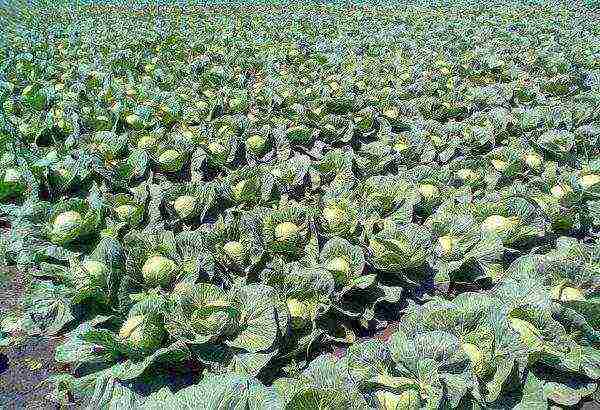 Aggressor
Aggressor
Amager - late cabbage with a ripening period 120-147 days... The heads are round-flat green, sometimes with a bluish tinge, weight about 3-4 kg.
When planting, the scheme is used: 3-4 plants per 1 m2. For six months, the nutritional value and presentation are preserved. Weather cataclysms and violation of the watering regime do not violate the density of the structure and the integrity of the head.
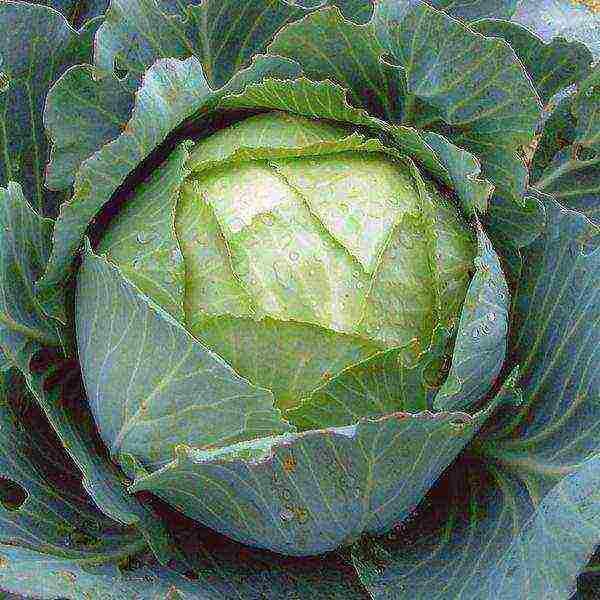 Amager
Amager
Valentine - growing season 155-180 days after transferring seedlings to open beds. The gray-green heads have a slight waxy coating, the weight is up to 4 kg.
Cabbage retains its taste and presentation until the beginning of the next season (June). The hybrid is tolerant to fusarium, gray rot.The head of cabbage does not crack due to violations of the moisture regime.
When planting, the scheme is used: 2-4 plants per 1 m2.
 Valentine
Valentine
Gingerbread man - hybrid forms heads later 115-125 days after planting seedlings. Round fruits have a dense structure, the average weight is 2-3 kg. Planting scheme: 3-4 plants per 1 m2.
Due to its good immunity, it exhibits tolerance to punctate necrosis and thrips. For 8-10 months, cabbage retains its nutritional value and presentation.
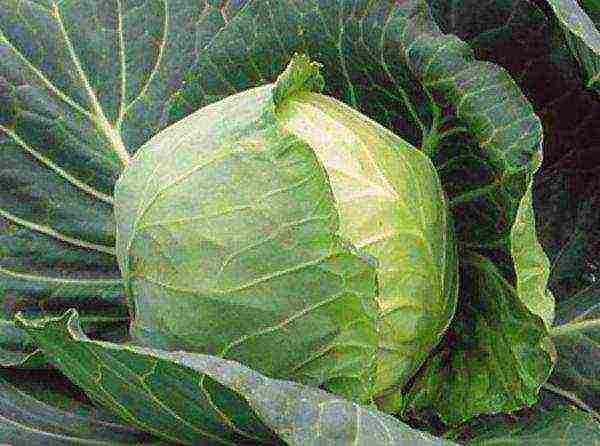 Gingerbread man
Gingerbread man
Mara - very dense heads are not susceptible to cracking, the average weight is 3 kg. The variety is distinguished by good taste, transportability and long shelf life (more than 7 months).
The main advantage is resistance to the accumulation of nitrates and radionuclides. Vegetables are harvested through 160-175 days after transplanting seedlings.
 Mara
Mara
Moscow - a variety developed by domestic breeders, who took into account the climatic features and possible problems with pests when growing.
Harvesting begins later 130-140 days after disembarking seedlings. Gray-green rounded heads of cabbage weigh 4-7 kg on average. When planting, the scheme is used: 2-3 plants per 1 m2.
Cabbage is resistant to cracking, has a delicate juicy pulp. Without loss of taste and presentation, the vegetable is stored for 6-8 months.
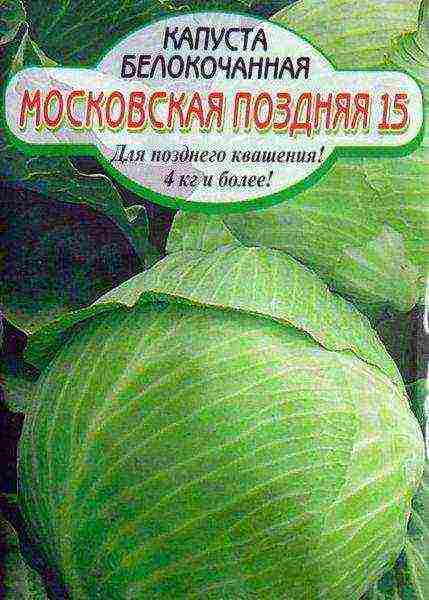 Moscow
Moscow
Mid-season white cabbage
Megaton - the hybrid matures in 102 days after planting seedlings. The great need for moisture and fertilizers strengthens the immune system, which resists many diseases and insect infestations.
The round-flattened gray-green head weighs up to 15 kg. The location of the holes when planting: 3 plants per 1 m2. Duration of storage without loss of nutritional qualities and presentable appearance is 4-6 months.
Merchant's wife - a disease-resistant high-yielding variety, distinguished by simple agricultural technology. About 500 centners are removed from a hectare (head weight up to 3 kg). When planting, the scheme is used: 3-4 plants per 1 m2.
Harvesting begins later 130-150 days after transferring seedlings to the beds.
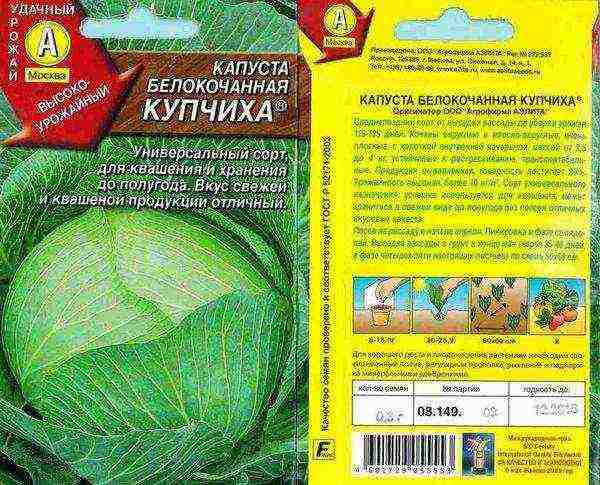 Merchant's wife
Merchant's wife
Atria - the fruit of the works of Dutch breeders with the growing season 110-120 days... The head of cabbage has a round-flat head of blue-green color, the average weight of which reaches 5-7 kg. Often there are specimens of 8-8.5 kg. When planting, the scheme is used: 3 plants per 1 m2.
Thanks to its good immunity, it resists pests (in particular thrips) and fusarium. The commercial and taste qualities are preserved for 4-6 months.
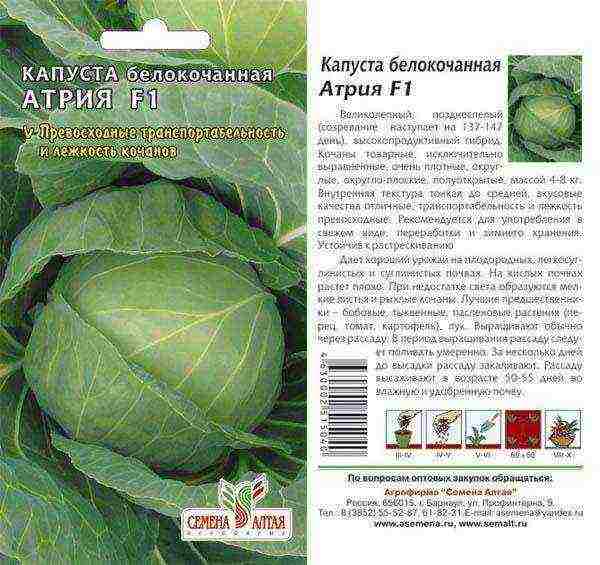 Atria
Atria
Glory - the fruit of the work of Russian breeders, the growing season is 120-130 day after planting seedlings.
Round heads have a light green color with a grayish tinge, the weight tightens up to 3-5 kg. When planting, the holes are arranged according to the scheme: 3-4 plants per 1 m2.
The advantage of the variety is its taste, the disadvantage is short storage (about 2 months). Glory is one of the best pickling options.
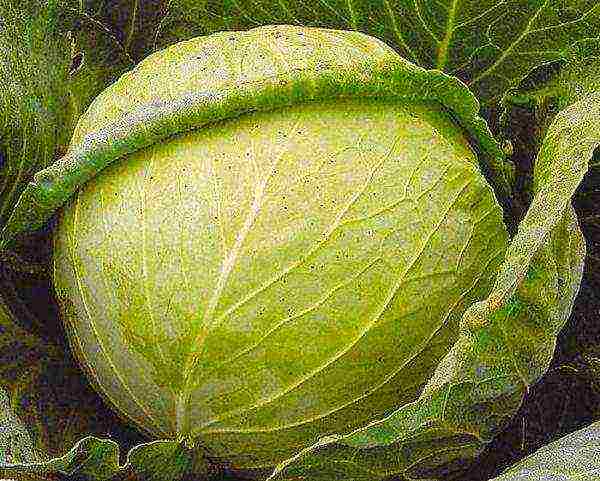 Glory
Glory
Sugar queen - the hybrid ripens after planting seedlings through 120-140 days... Dense rounded heads have a slightly greenish tint, weighing up to 4 kg.
When planting, the scheme is used: 3 plants per 1 m2. The variety is universal, it is used fresh and for salting. The shelf life without loss of valuable qualities is 3-4 months.
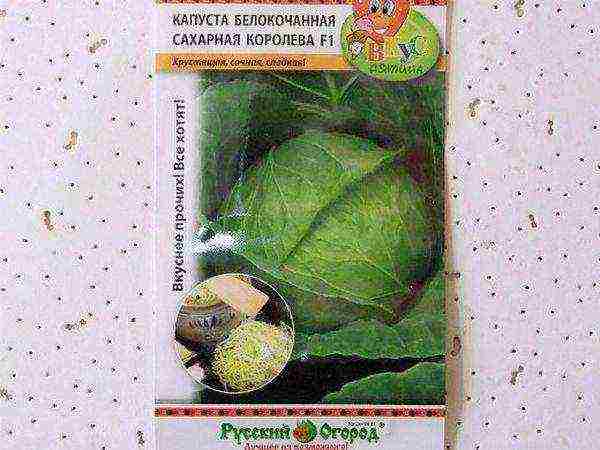 Sugar queen
Sugar queen
Early ripe
Rinda - the ripening period of the hybrid is 75-80 days after disembarking seedlings. Round heads weighing up to 7 kg have a green color and a dense structure. Hole layout: plant 3-5 plants per 1 m2. Differs in unpretentiousness to weather conditions.
The shelf life without loss of taste and presentation does not exceed 4 months.
 Rinda
Rinda
Kazachok - an early hybrid is distinguished by early maturity, you can harvest through 45-55 days after disembarking seedlings. The weight of the medium-sized light green head is 1.5 kg.
The scheme used for planting: 5-6 plants per 1 m2.Recommended for cultivation under any kind of film and in the open field. Cabbage resists the causative agents of mucous bacteriosis and black leg.
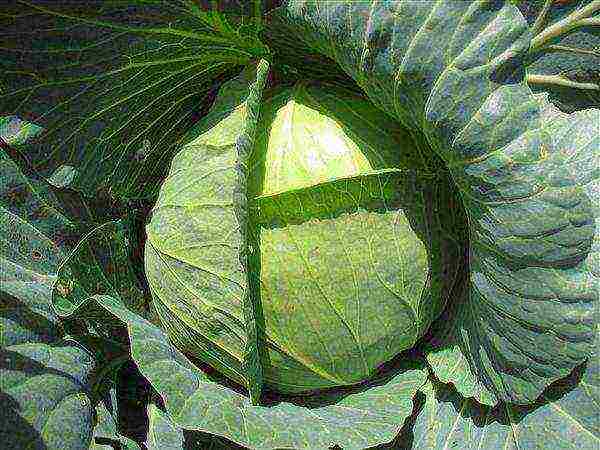 Kazachok
Kazachok
June - the variety is ready for planting in open ground already at the beginning of May, after 45-50 days you can harvest. The structure of the head is of medium density, the weight reaches 1.4-1.7 kg. When grown on highly fertile soils, the weight of the head of cabbage reaches 5 kg.
The layout of the holes when planting: 3-5 plants per 1 m2. Cabbage is distinguished by the amicability of the emergence of seedlings and excellent taste.
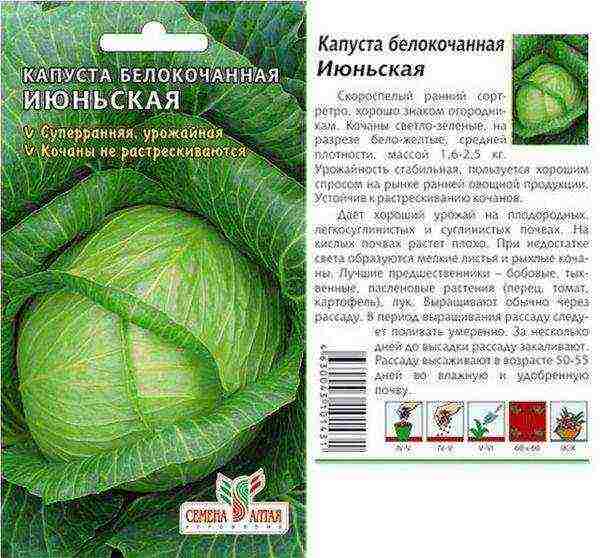 June
June
Tobia - Dutch hybrid characterized by resistance to fusarium wilt. The layout of the holes when planting: 2-3 plants per 1 m2. Dark green round-flat heads weigh up to 7 kg. Fruit ripening occurs later 85-90 days after disembarking seedlings.
It has a strong root system, if the irrigation regime is violated, the head of cabbage does not crack. It retains its taste and marketability for 5-6 months.
 Tobia
Tobia
Varietal variety will ensure productivity even in difficult weather conditions, because each plant has its own immunity to diseases and pests. The taste qualities of the varieties stimulate new experiments, which continue already in the kitchen.

“Beetroot varieties are some of the best among these vegetables.
Wood ash as fertilizer - help in the garden, flowers and in the garden "
The best varieties of cabbage for regions with descriptions and photos - early, middle and late
What varieties of cabbage are best grown in different regions of Russia
Different regions of Russia have their own best varieties of white cabbage (the article will contain their description and photos). She is one of the most demanded vegetables, along with beets, potatoes and carrots, on the table among the peoples of many countries of the world. You can talk for a very long time about its benefits, taste and healing qualities. Talking about which variety is better is useless, because everyone has their own taste. Some people like tender cabbage of early varieties, others like sauerkraut, and still others prefer heads of cabbage intended for storage.
So how can a gardener begin to grow cabbage to decide on the choice of a variety? First, you need to determine which cabbage ripening period is needed and in what quality it will be used. Secondly, on the basis of her choice in terms of ripening, consult with neighbors in the summer cottage, find out from them what they are growing and what results they are achieving. Thirdly, find more detailed information in the press or on the Internet about the selected varieties or hybrids of vegetables.
Many are convinced that 5 - 6 varieties should be grown in order to obtain a uniform harvest according to the season and its rational use in winter. Two early, ripening at different times, one mid-season for fermentation and two - three late for late fermentation and laying in a cellar for winter storage.
For the middle lane
The middle zone of Russia is the most favorable for growing cabbage, therefore, most of its varieties are zoned here, some of which are widespread in adjacent regions. Conditions for the growing season of these vegetables are similar to this region - in the Far East, South Urals and the south of Western Siberia... Therefore, most of the best varieties of our vegetables from central Russia are grown in these regions as well.
Early cabbage types for this region
Early cabbage is planted for summer consumption. She goes to salads, cabbage soup, borscht, and other soups. It is also suitable for extinguishing. The main criteria for choosing the best examples of these vegetables: the taste and juiciness of the heads of cabbage, how they are prone to cracking, whether they can prematurely release a flower arrow. Early cabbage can be eaten a couple of months after planting in a greenhouse, protected or open ground, so all varieties of it are grown in any climatic zone, with some exceptions. The best early vegetables are both mouth-watering leaves and heads of cabbage after a short period of time. They can endure chilly springs, matinees and close landing on the site.Such varieties, which are lighter than others, withstand a lack of fertilizer in the soil. But if the volume of collection is the main thing, then you have to worry about feeding the cabbage.
June
One of the most popular in our country. It is so named because its first crop is harvested at the end of June. The taste is very high. The disadvantage is that the harvest of vegetables ripens at the same time, you have to harvest in one or two steps. In the future, the heads of cabbage crack and lose marketability. Seedlings are planted with the "June" very first garden crop, as it can tolerate spring five-degree (with a minus sign) matinees. Weight 1.2 - 2.2, yield - 3.9 - 6.1.
! Note: Hereinafter, the weight is indicated in kilograms, the yield in kilograms per 1 sq. m!
Kazachok
Heads of cabbage, used mainly fresh, ripen in the same period as June. The variety does not crack or get sick, due to the rise of small round heads of cabbage above the soil surface. The same quality allows for mechanized harvesting. Average weight - 1.05, yield - 4.8 - 7.2.
Transfer F1
Cabbage, which needs 85 - 117 days from the appearance of cotyledon leaves to a not very large fork. Its outer leaves are of a pleasant pale emerald hue, inside are almost milky. The mass of a vegetable is not more than one and a half kilograms (usually, about 1). The taste is delicious. Stable collection, with a large yield of tight heads, maturing amicably at the earliest possible date. Heads of cabbage do not burst. The variety is weakly susceptible to disease and perfectly withstands cold spring. With a fairly high level of fertility, it yields a crop of up to 7.5 kg.
Number One Gribovsky 147
It sings 8 - 16 days later than June. Thanks to this, they can be grown in the garden to extend their consumption. The forks of "Gribovskaya" are mostly rounded, less often oval. They are well adapted to cold snaps and drying out of soil moisture. Average weight - 1.1 - 1.8, yield - 3.1 - 5.8.
Dot
Very early cabbage. The first use of loose heads of cabbage begins after a month and a half of the growing season. Medium-density cone forks. The leaf coverts of vegetables are light green. The cut cabbage is whitish-yellow in color. Average weight - 0.9 - 1.5, yield - 3.1 - 6.4.
Stakhanovka 1513
Ripening occurs a little later than the varieties described above, due to this, the weight of the forks and the yield increase. Stakhanovka is eaten fresh and fermented successfully. It has round medium density forks. Average weight - 1.7 - 3.2, yield - 4.8 - 7.2.
Malachite F1
It only takes two months from seedling to harvest. Very rounded, weighing 1.2 - 1.4, stuffed, does not burst. It stands out for its remarkable raw food flavoring qualities. It matures at once, harvested in 7 - 13 days. Harvest 3.8 - 6.3.
Types of mid-season cabbage
This cabbage pleases gardeners in the middle and late summer. Its heads are more juicy, contain a lot of sugars, they absorb a large amount of moisture and, as a result, are very responsive to watering. Mid-season products are ready for selective harvesting when the early varieties of vegetables are already leaving. They eat it fresh, but more often they ferment it.
Belarusian 455
A popular old variety, zoned for a long time, its juicy heads of cabbage ripen in a little over three months. "Belorusskaya" is perfect for sourdough, both cut into quarters with forks, and finely chopped. Average weight - 1.5 - 3.9, yield - 5.1 - 7.3.
Sibiryachka 60
"Sibiryachka" sings faster than "Belorusskaya" for about a week. The forks are loose, so they hardly crack, they are cold-resistant enough. Sibiryachka is used in fresh autumn and winter. And it is good for fermentation. Average weight - 2.6 - 4.0, yield - 4.9 - 7.5.
Golden hectare 1432
It ripens four months after mass shoots. The shape of the heads is almost a perfect ball, they taste good. Rich in vitamin "C", according to this indicator - the leader among representatives of cabbage. Vegetables have even, dense, leveled heads of cabbage."Golden hectare" is resistant to cracking, forks do not last long, they are mostly fermented. Average weight - 1.9 - 3.0, yield - 5.6 - 7.9.
Glory 1305
In our opinion, Slava is the best in sourdough. It is very fruitful, with amicable response and early autumn ripening. The heads of cabbage are so dense that they are prone to cracking, so they need to be removed and fermented on time. "Glory" is stored only until the New Year. Average weight - 2.7 - 4.2, yield - 6.1 - 8.7.
Hope
The most productive of the mid-season. Ripens in late summer. Lies until February, then withers quickly. It ferments well, in sourdough and fresh it is very tasty. The head of cabbage at "Nadezhda" is round, dense, does not crack. The average weight of a vegetable is 3 - 3.5, yield - 7.5 - 11.9.
Present
"Gift" is very versatile, very tasty. Fresh salads, preparations for the winter, pickled forks - everything is at the highest level. Cabbage is stored until mid-winter. It has round and rather large heads of cabbage, growing on average for about four months. "Gift" is resistant to cracking. Weight (on average) - 2.9 - 4.1, yield - 7.1 - 8.8.
Rinda F1
Mid-season cabbage hybrid. Head of cabbage is round. Rinda F1 is tasty raw and good for winter canning. Can be stored in cold rooms for up to three months. The inner texture of the fork (3.3 - 3.6) is excellent, loosely packed. Leaf without harsh bitterness and with a special aftertaste. The amount of the fee depends on the circumstances of the cultivation. It grows well both in spring planting and in summer sowing. Collection 8.7 - 9.2.
Semko Jubilee 217 F1
They are used in natural form, in pickles and for storage (up to six months). The maturity of the heads occurs at 125 - 136 days. The forks are stuffed or very tight. The weight of the head of Semko is from 3.8 to 4.1 kilograms. The palatability of raw and sauerkraut is excellent. Collection 7.6 - 8.5. Disease resistant.
From late-ripening (late) varieties of cabbage
Late cabbage is the leader in yield. It is not surprising, because such vegetables grow the longest, almost five months. This cabbage is richer than all other vitamins and sugars. Her heads of cabbage lie in good conditions until the next harvest. Another feature of the late varieties is an improvement in their taste during maturation, which is due to the transformation of sugars inside the head of cabbage.
Amager 611
An unpretentious popular variety of cabbage. Due to its bitterness, it is slightly affected by insects: caterpillars and aphids. During incubation, the bitterness disappears, the heads of cabbage gain juice, and their taste improves. Of the late ones, "Amager" ripens in the first place, and is stored until April. He does not tolerate heat well. Regular watering of vegetables and mulching the soil around them is mandatory, especially in dry summers. Average weight -2.8 - 3.4, yield - 3.8 - 6.3.
Kharkov winter
The dense heads of this popular old variety are flat and even flat-convex, do not crack and store very well. Harvested in October, they will last until spring under appropriate storage conditions. "Kharkiv winter" tolerates heat and cold well, heads of cabbage should be removed after they "have enough" frost. These vegetables are mainly eaten fresh, and they are also suitable for canning. Zoned only along the southern border of the middle zone. Average weight - 3.6 - 3.9, yield - 6.1 - 8.1.
Moscow late 15 (9)
The popular late cabbage is the leader in terms of its own weight of the head of cabbage. Cold-resistant, easily tolerates negative temperatures, both in spring and autumn. "Moscow late" is very responsive to watering and feeding, because it needs to gain a large mass and a huge amount of vitamins and sugars. This cabbage is stored very well and is one of the few late-ripening cabbage that can be fermented. Ripens "Moscow late" four and a half months after germination. Average weight - 3.6 - 4.2, yield - 6.8 - 8.1.
Wintering 1474
"Wintering" grows for a very long time. The growing season for vegetables is about six months. But it also lies, but all winter and spring, it is not without reason that it is so named.With long-term storage, it gives almost no waste, and the taste only improves. Very dense, medium-sized head of cabbage. Average weight - 2.2 - 3.4, yield - 4.6 - 5.1.
Midor
Medium late monohybrid with a period of 135 - 159 days before harvest. The leaves are bright green, the wrinkling is weak, the wax coating is excellent. Head of cabbage (2.7 - 3.8) simple, spherical and stuffed, the inner leaves are snow-white. A stump in the back is a short fork. The taste is delicious. You can make vegetable salads and ferment for the winter. Collection 5.7 - 7.2 kg.
For Moscow region
In the Moscow region, the following are zoned from the above:
- Early: "Number One Gribovsky", "Golden Hectar", "Stakhanovka".
- Mid-season: "Glory", "Belorusskaya", "Gift".
- Mid late: "Winter Gribovskaya".
- Late: "Moscow Late", "Amager".
For the Urals
The conditions of the Northern Urals for vegetables are similar to those of Eastern Siberia. Some of the varieties already mentioned are grown in these areas.
- Early: "June", "Number one Gribovsky", "Stakhanovka".
- Average: "Golden Hectare", "Glory", "Belorusskaya", "Gift".
- Late: "Winter Gribovskaya", "Amager".
And also zoned such as:
Early ripening
Bred from crossing various varieties of old German cabbage "Dietmarscher". Sung before the "Number of the first Gribovsky". The forks are aligned, presentation. It is similar to June, only loses in terms of yield. Zoned for the North-West region and Western Siberia in 1973. Average weight - 0.9 - 1.1, yield - 3.7 - 5.2.
Polar K - 206 (number one polar)
Early variety. Bred in 1950 by selection from samples of the "Number of the First Gribovsky". He is five to ten days later than his parent. But the weight of the heads of cabbage and the yield are noticeably higher, and, in contrast to "Gribovsky", can be used for fermentation. Ripening is not uniform, which makes it possible to extend the harvesting period of the product. Forks are not resistant to blooming and cracking. Average weight - 1.9 - 2.8, yield - 4.7 - 5.9.
For the south of Russia
These areas are characterized not only by a warmer climate, but also by shorter daylight hours. And therefore, the requirements for vegetables, and in particular for cabbage, are slightly different here.
From zoned in the central zone, they grow here:
- Early: "Number one Gribovsky."
- Mid-season: "Glory".
Mozharskaya local
Most likely, this is folk selection, since there is no documentary material about its origin. Medium late rounded flat cabbage, quite heat-resistant. It is well transported and lies. Suitable for leavening. Average weight - 2.7, yield - 4.9.
Judge 146
An old southern mid-late variety of cabbage. Tolerates elevated temperatures. Fresh and recycled are the best use cases. Average weight - 2.3, yield - 4.7.
In addition to the usual division of vegetables into early, medium and winter varieties, in the south of Russia they are zoned for autumn and sub-winter crops.
Zavadovskaya
For autumn sowing. Ripens five to six months after sowing. Heat-resistant, prefers fertile soil. Her forks are round, dense. "Zavadovskaya" is fermented and eaten fresh. Weight - 7.7, yield - 16.9.
Derbent local improved
"Derbentskaya" was bred specifically for the southern regions, sown before winter. After three months, it is ready for use. Medium cone forks. Average weight - 1.1 - 1.5, yield - 2.6 - 3.4.
Using my experience, reviews of gardeners from the forum and neighbors in the country, I will list here the best varieties of cabbage. Moreover, these varieties are suitable for the Urals and Siberia, as well as for central Russia.
Cabbage varieties with photos and descriptions, reviews
June cabbage, characteristic
An early ripening variety of cabbage, intended for fresh consumption, that is, immediately on the table. The heads of cabbage of this variety are round, weighing up to 2.5 kg. The color of the head is pale green with a slight waxy bloom. The density is average.
The variety is resistant to cracking. Harvesting "June" cabbage is carried out 60-70 days after planting seedlings. An important quality of this variety for the regions of the Urals and Siberia is that it tolerates frosts down to -5 degrees.
June cabbage yield: 6 kg / m2. sq.
Cabbage Zarya
The best early (118 days from germination to technical ripeness) variety of cabbage, resistant to cracking. Heads of cabbage are round, small, of medium density, weighing up to 2 kg. A variety for fresh use.
The Zarya variety gives high yields even with a low use of nitrogen fertilizers. High yield, good ripening and high commercial qualities of fruits are the indisputable advantage of this variety.
Cabbage yield Zarya: 3.4 - 10 kg from 1 sq.m.
Cabbage Express F1, description, photo
An early ripe hybrid of domestic selection of white cabbage. The period from full germination to the beginning of technical ripeness is 60-95 days.
The rosette of leaves is raised. The leaf is small, light green with a slight waxy bloom, flat.
The head of cabbage is round, medium density, uncovered, medium density, whitish on the cut. The outer and inner stumps are short. The average weight of the head is 0.9-1.3 kg. The taste is high quality.
Cabbage yield Express: up to 3.8 kg from 1 sq. m.
Advantages of the hybrid: high yield of marketable products, excellent taste, friendly formation of early products.
Cabbage hybrid Express F1 is included in the State Register of the Russian Federation for the Central and Central Black Earth Regions.
Cabbage Gift, photo
One of the best medium-late varieties of white cabbage for pickling and pickling. From the moment of planting seedlings to harvest, 110-120 days pass.
Light green, dense heads of cabbage, rounded or flat-rounded, as if covered with a waxy coating. Usually their weight is from 2.5 to 4.5 kg. The variety has excellent taste and is recommended for fresh consumption and fermentation.
Cabbage yield Gift - up to 10 kg from 1 sq.m.
It is advisable to plant seedlings according to the scheme: 60 cm x 50 cm. This variety is recommended both for growing in the Urals and Siberia, and in other regions of Russia.
Cabbage Aggressor F1, description
A popular mid-late ripening (from germination to fruiting 115-120 days) hybrid of Dutch selection, with high growth rates, stable yield under any conditions and the ability to short-term storage (up to 5 months).
The head of cabbage is flat-rounded, medium-sized, leveled, dense, weighing 3-5 kg. Resistant to cracking. Does not require special care. Perfect for risky farming zones (Siberia and the Urals). It tolerates a lack of nitrogen nutrition and unfavorable weather conditions.
Cabbage yield Aggressor: 4.3-6.5 kg from 1 sq.m.
High yield of marketable products and excellent taste make Aggressor cabbage ideal for fresh consumption, pickling and pickling. The hybrid is particularly resistant to damage from thrips and fusarium wilt.
Cabbage Slava-1305, description
The classic variety of cabbage, best adapted to the most varied climatic conditions. Ripening period 85-100 days.
Heads of cabbage are round, weighing from 2.5 to 4.5 kg, dense.
This variety is considered one of the most productive medium-sized varieties of white cabbage. In addition, it is stable, cold-resistant, and transportable. It also tastes good. The dense, round heads of cabbage are light green on top and white on the inside.
Slava is the best variety of cabbage for pickling and pickling.
Cabbage yield Slava - up to 12 kg from 1 sq.m.
Cabbage Amager 611
A late-ripening variety of cabbage, ripening occurs 115-120 days after full germination. Heads of cabbage are round-flat, dense, weighing 3-3.5 kg.
Amager is the best variety of late cabbage, it is perfect for pickling. The taste only improves during storage.
Productivity of cabbage Amager 611: 5 - 6 kg from 1 sq.m.
Late Moscow cabbage
One of the most productive large-fruited cabbage varieties.
The weight of one head of cabbage is usually 7-8 kg, the limit is 15 kg. Heads of cabbage are round, green.
This is one of the best sauerkraut varieties.
Cabbage yield Moscow late: 10 - 12 kg from 1 sq.m.
Cabbage Megaton F1, description
High-yielding, medium late (102 days from germination to fruiting) hybrid of Dutch selection.
The head of cabbage is flat-rounded, dense, weighing up to 15 kg. Cabbage Megaton - hybrid No. 1 for fermentation, with high taste. Also suitable for processing and fresh consumption.
It is the most productive medium-sized cabbage hybrid. Differs in high resistance to fusarium. Demanding on soil moisture and needs high doses of fertilizers.
Megaton cabbage yield: 5.86 - 9.34 kg per sq. m.
Rinda Cabbage F1
Excellent mid-early (95-105 days from germination to fruiting) hybrid of Dutch selection.
Heads of cabbage are large, round, with a dense and thin internal structure, weighing 5-8 kg, white on the cut. The stump is small. It is intended for fresh consumption, fermentation and short storage (from 2 to 4 months).
White cabbage Rinda f1 is distinguished by the evenness of the heads, high yield in various climatic conditions, and the ability to survive for a long time on the vine.
Rinda cabbage yield high.
Cabbage Hope
Mid-season (from germination to ripening 115-135 days), a productive variety of cabbage.
The head of cabbage is flat-round, pale green, weighing up to 5 kg. Resistant to cracking. The taste is high. Recommended for fresh consumption, fermentation and short-term storage (up to 3 months). Transportability is good.
Cabbage yield Hope - up to 13 kg / m².
Cabbage Gingerbread Man
A high-yielding late-ripening hybrid variety of cabbage that ripens only 150 days after germination.
Heads of cabbage are dense, round, weighing up to 5 kg, resistant to cracking. The inner stump is short. Heads of cabbage are green above, white in section.
The variety is resistant to cabbage bacteriosis, as well as to fusarium leaf wilting, to white and gray rot. Cabbage Kolobok is ideal for storing it for the winter, as well as for pickling. In good conditions, the heads of this variety can be stored until May next year.
Cabbage yield Kolobok: 7 - 12 kg / sq. m.
Sowing seedlings in mid-April. It is advisable to plant seedlings in the ground 50 days old according to the scheme 50 × 70 cm.
These are varieties and hybrids of cabbage for open ground.
We recommend purchasing cabbage seeds of excellent quality in the Sady Rossii online store.
If you grow other varieties of cabbage and they delight you with excellent taste and bountiful harvest, share their names with us in the comments. After all, it is impossible to try all varieties at once, but you want to plant only the very best. If possible, attach a photo of the cabbage you have grown.
Due to its keeping quality (mid-late and late varieties), fresh vegetable products are on our table almost all year round. The choice of varieties and hybrids of white cabbage is huge: from early to late maturing; by weight of a head of cabbage from 600 g to 20 kg; by head density: from loose to dense. In total, 342 names of varieties and hybrids of white cabbage have been zoned in Russia.
Early and mid-early varieties and hybrids are intended for consumption fresh, stewed, boiled: in salads, soups, pies.
In central Russia, cabbage is grown through seedlings. The term for sowing seeds of early-maturing varieties and hybrids is 2-3rd decade of March, late-ripening - 1st decade of April, mid-season and mid-late - 3rd decade of April.
Wet and light soil is best for sowing. The seeding depth is 1-1.2 cm, deeper sowing delays the germination time. Cabbage seeds germinate and develop quickly. In the early days, it is worth strictly monitoring the soil moisture and, if necessary, watering. Usually, seedlings appear on the 3-4th day.When 2-4 true leaves are formed, the seedlings are dived and transplanted into separate cups.
In general, the average age of seedlings suitable for transplanting should be 30-40 days. During this period, it should have 5-6 true leaves and a well-developed root system.
The optimal timing for planting seedlings in the ground in the Non-Chernozem zone: for early cabbage - 1st decade of May, for middle and mid-late 2nd - 3rd decade of May; for late - 3rd decade of May -1th decade of June. It is advisable to plant seedlings in cloudy weather. Usually, a distance of 60-70 cm is left between the rows of cabbage, and 35-50 cm in the row between the plants. When planting, the plants are buried in the ground to the first true leaf. Wet ground on top is mulched with dry peat.
The main care is weeding, loosening, regular watering and pest control. The soil is loosened to a depth of 5-8 cm, and the depth of subsequent loosening is brought to 12-15 cm. The depth of loosening is determined by weather and soil conditions. With a lack of precipitation, the soil is loosened finer, with an abundance, deeper.
Cabbage responds positively to hilling. The number of hilling depends on the height of the stump. Varieties with a short stump are spud once, with medium and high ones - 2-3 times. The first hilling is timed to the beginning of active growth of the leaf rosette, that is, after 25-30 days, and the next one - until the leaves close.
Early varieties of white cabbage
As for the assortment of early maturing varieties and hybrids, the following are worthy of attention.
Sprint F1... The technical ripeness of the heads of cabbage occurs 85 days after germination. The head of cabbage is round in shape, with a small internal stump, dense. Weighing 0.9-1.6 kg. Resistant to cracking. The amicable ripening of heads of cabbage is characteristic.
Senorita F1... It takes 100 days from germination to harvest. A head of cabbage is rounded, weighing 1.1-1.2 kg, with a fine internal structure, dense, with excellent taste. The hybrid is amicable in ripening and resistant to head cracking.
F1 sympathy... Ready to use in 100 days. A head of cabbage is rounded, weighing 1.5-2 kg. The hybrid is amicable in ripening, resistant to cracking, transportable, quickly adapts to environmental conditions and gives stable yields.
See also: White cabbage - cultivation, varieties, as well as planting and care
Medium early varieties
Mid-early varieties and hybrids are ideal for fresh consumption in July and August.
Maid of honor F1... Heads of cabbage ripen 105-110 days after germination. They are round in shape, weighing 1.6-1.8 kg with an excellent internal structure. The hybrid is distinguished by good adaptability to environmental conditions, stable yields, excellent taste, and resistance to cracking.
Ataman F1... The period from planting seedlings to harvesting is 65-70 days. The rosette of leaves is raised. The head of cabbage is round, whitish on the cut. Weight 1.2-1.8 kg. Great taste. The hybrid is resistant to fusarium wilt. Recommended for fresh use.
Medium white cabbage
Mid-season varieties and hybrids are intended for fresh consumption from August to November, as well as for fermentation.
Countess F1... From planting seedlings to harvesting, 85 days pass. The head of cabbage is medium, round in shape, dense, weighing 2-3 kg, with an excellent internal structure and taste, white on the cut. The hybrid is characterized by amicable ripening, resistance to fusarium wilt and thrips damage, used for fermentation and processing.
Rematch F1... The period from planting seedlings to harvesting is 85-90 days. The head of cabbage is round, whitish on the cut. Excellent taste. Head of cabbage weight 3 kg or more. Recommended for fresh consumption. Weakly affected by diseases and pests.
Medium to medium late white cabbage varieties
Mid-late varieties and hybrids combine high yield, keeping quality and good quality of heads.Due to the high content of sugars and dry substances, they are ideal for fermentation and fresh consumption.
Table F1... Ripens 115-125 days after transplanting. The head of cabbage is round-flat, weighing 3.5-5.5 kg, with a good internal structure. Differs in amicable formation of the crop and high resistance of heads of cabbage to cracking. The hybrid is ideal for fermentation and fresh use from September to January. According to the tasting assessment in fermented form, this hybrid surpasses all other domestic and foreign samples.
Princess F1... From planting seedlings to harvesting passes 115-120
days. A ripening friendly hybrid, resistant to cracking, transportable. A head of cabbage of medium size, weighing 3.2-3.7 kg, round in shape, with an excellent internal structure. It is used for fresh consumption, fermentation and storage for 3-4 months.
Filibuster F1... It ripens in 120-130 days after transplanting. Recommended for fermentation from the moment of harvest to the end of the storage period, also for fresh consumption. The hybrid is resistant to necrosis of the inner leaves of the head of cabbage and to fusarium wilt.
Symphony F1... The period from planting seedlings to harvesting is 120-130 days. The head of cabbage is rounded, with an excellent internal structure, whitish in cross-section. Weight 4 kg. The taste is excellent. The hybrid is resistant to cracking, forms a harvest together.
You can also read about varieties of white cabbage here
Late varieties of white cabbage
Late-ripening varieties and hybrids are valuable not only for their high yield, but also for the fact that they ensure the supply of fresh vitamin products to our table throughout the winter and even the beginning of spring.
Arctic F1... The technical ripeness of the heads of cabbage occurs 130-140 days after transplanting. A head of cabbage of medium size, dense, round, weighing 2.5-3 kg, with excellent taste. The hybrid is resistant to a complex of diseases. It is kept fresh until a new harvest.
F1 Guarantor... It takes 140 days from planting seedlings to harvesting. A head of cabbage weighing 2-3 kg, dense, with excellent taste. The hybrid is resistant to a complex of diseases. Recommended for fermentation from the moment of harvest to the end of the storage period.
Morozko... The period from germination to harvest is 140-145 days. The head of cabbage is round, weighing 2-3 kg, very dense, with good taste. The variety is distinguished by its head resistance to cracking and high keeping quality. Recommended for long-term storage.
Beaumont Arpo F1... The period from planting seedlings to harvesting is 130 days. A head of cabbage is round, very dense, with an excellent internal structure, of medium size, weighing 3.5-4 kg. Differs in good keeping quality until February, resistance to necrosis of the inner leaves of the head. The taste is excellent.
Cupid F1... It ripens 130 days after transplanting. A head of cabbage is round, very dense, of medium size, weighing 3-3.6 kg. The taste is excellent. The hybrid is plastic, with amicable crop formation, resistant to fusarium. Recommended for fresh consumption, fermentation and storage (until February).
New resistant cabbage varieties for minimal processing
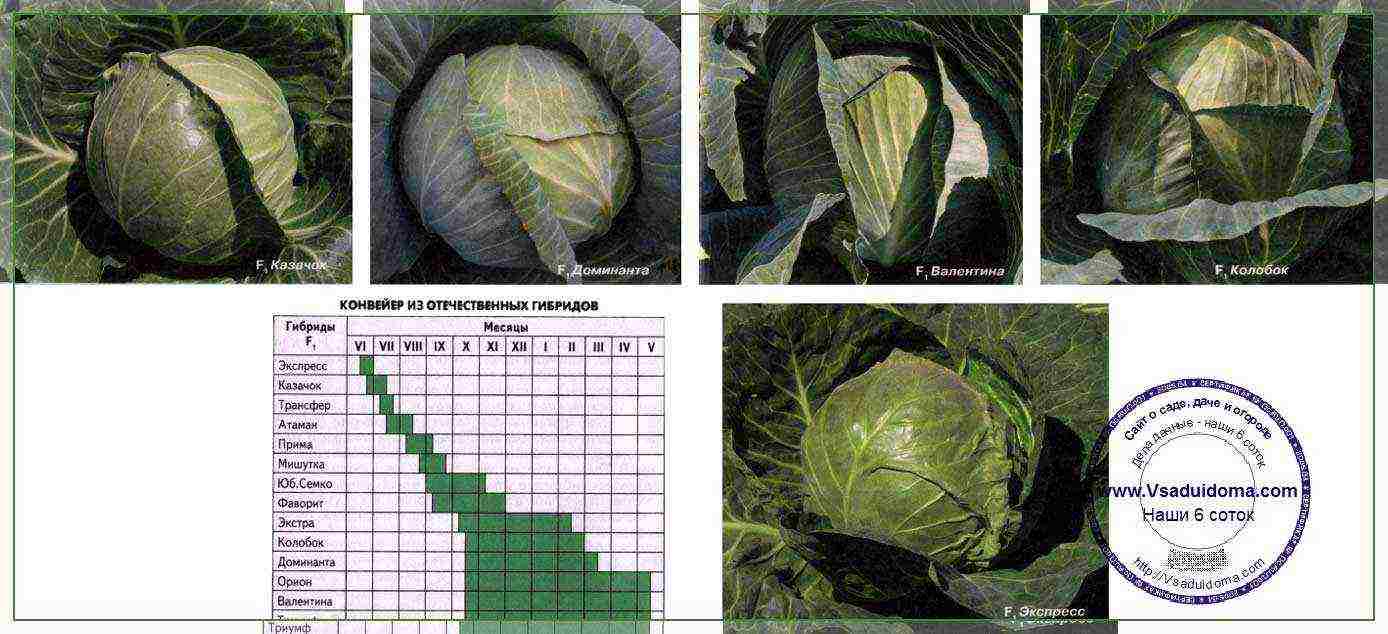
So, are there any novelties that can compete with old and proven varieties?
Summer residents are often very conservative in the choice of varieties, but recently many wonderful Russian hybrids have appeared, which make it possible to organize a conveyor for the supply of fresh cabbage all year round
However, each foreign transnational company has its own assortment in stock, which makes it possible to organize such a conveyor.
And if a person wants to grow cabbage to everyone's surprise, for example the largest, what varieties should you pay attention to? And what kind of agricultural technology do the giants need?
All records for growing large cabbage, starting with the gardener Pyshkin, were obtained on cabbage varieties Pyshkinskaya... On its basis, a variety was created Moscow late 15... Other large cabbage varieties - Moscow late 9, Losinoostrovskaya 8, Taininskaya, of foreign hybrids, it can be noted F1 Megaton and F1 Menzania... In the Moscow late variety, the weight of the head of cabbage can reach 25 kg. But for this, the seeds must be sown in mid-March, then the seedlings must be grown in a greenhouse for 60 days, and the cassettes must be with a cell diameter of 6 or 10 cm.The seedlings are planted at the end of April in a previously fertilized fertile soil, providing a feeding area of 1 × 1 m.
The main challenge of the 2015 season is a severe attack on cabbage with keel in the non-chernozem zone of the Russian Federation and vascular bacteriosis in the Republic of Mari El and in the floodplain farms of the Volga region and the Moscow region. There are no varieties resistant to this disease in the Russian variety of white cabbage, but there are some in the world. This is F1 Kilaton, F, Tequila etc. However, even they cannot be grown on the same plot for two years in a row.
Foreign hybrids F1 Tserox, F1 Aggressor, 1% F1 Satti, F1 Braxan are highly resistant to vascular bacteriosis, as well as Russian - F1 Prestige, F, Dominanta and F1 Orbita. However, at least 6 races of this disease are known on the territory of Russia, and the listed hybrids are resistant only to 1-3 races. Now breeders all over the world are faced with the goal of creating hybrids with group resistance to the three most harmful diseases - keel, fusarium and vascular bacteriosis. And the testing of the first hybrid combinations has already begun for the subsequent transfer to the state variety testing.
For the southern and central regions, an important problem has become a strong infection of cabbage heads with tobacco thrips, and in this regard, a dilemma arose: to treat cabbage 8-10 times with potent insecticides or create stable hybrids? At the moment there are no such ones, from foreign ones, F1 Aggressor is distinguished by high tolerance, and from domestic ones - F1 Dominant.
Many readers ask if there are varieties that can be grown in high temperature and lack of water?
The breeding of heat-resistant varieties and hybrids has been carried out in our country for a long time, and a lot of them have been created at the Krasnodar Research Institute of Rice. Among heat-resistant hybrids for long-term storage, domestic hybrids show excellent results F1 Dominant, F1 Quartet, F1 Orbit and foreign Bronco, Typhoon, Aggressor, Adapter... At the same time, it should be noted that heat resistance and drought resistance are completely different characteristics. There is no drought-resistant (at the saxaul level) cabbage. And whether it is necessary, because it will not be juicy or tasty. Even heat-resistant cabbage needs watering, and with sprinkling, the yield is higher than with drip irrigation. Lack of water, say, during prolonged drought, leads to the fact that young leaves are deficient in calcium and die off.
If such a head of cabbage is cut, interlayers of dark dead leaves will be visible. This will not affect keeping quality, but marketability is sharply reduced. Among domestic late hybrids, F1 Orion and F1 Dominant hybrids are distinguished by high resistance to this physiological disorder.
Of course, the idea may arise to grow southern varieties in the middle lane. But since they were created in a short day, in the Moscow region, where the day is long, the head of cabbage will form later. It can grow very large, but with voids inside, a strongly elongated inner stump, which will reduce the commercial quality. And southern cabbage is not intended for long-term storage, since it is harvested there in mid-late November.
Do Russian varieties and hybrids have advantages over foreign ones?
Each hybrid has both advantages and disadvantages, depending on the purpose of its creation. The main advantage of foreign hybrids is exceptional morphological homogeneity, but this trait has nothing to do with yield and does not at all justify the prohibitive cost of seeds. Domestic breeding hybrids (in particular, in the late cabbage sector), although not so uniform, have exceptional keeping quality.This is important: more than 70% of cabbage is consumed in winter, which lasts about 7 months. The best hybrids of the Russian selection F1 Bomotd-Agro, F1 Kolobok, F1 Extra, F, Prestige, F1 Dominant, F1 Valentina, F, Orion, etc., resistant to fusarium, have excellent taste.
Below are other entries on the topic "Cottage and garden - do it yourself"
Savoy cabbage - growing and care: Cultivation of Savoy cabbage - fruitful ... White cabbage: early and late varieties, care and seedlings .: About caring for white cabbage ... How to grow cauliflower: care, how to fertilize and the best varieties: Cultivation of cauliflower - varieties ... Growing white cabbage - planting and care (Tver region): Planting and caring for cabbage ... The best varieties and hybrids of vegetables at the end of the year - our reviews: What varieties and hybrids showed ... Cauliflower and broccoli - cultivation, varieties, care, properties : How to grow cauliflower and ... Simple white cabbage: benefits and properties: Useful properties of white cabbage Today in ...
Subscribe to updates in our groups.
Let's be friends!

